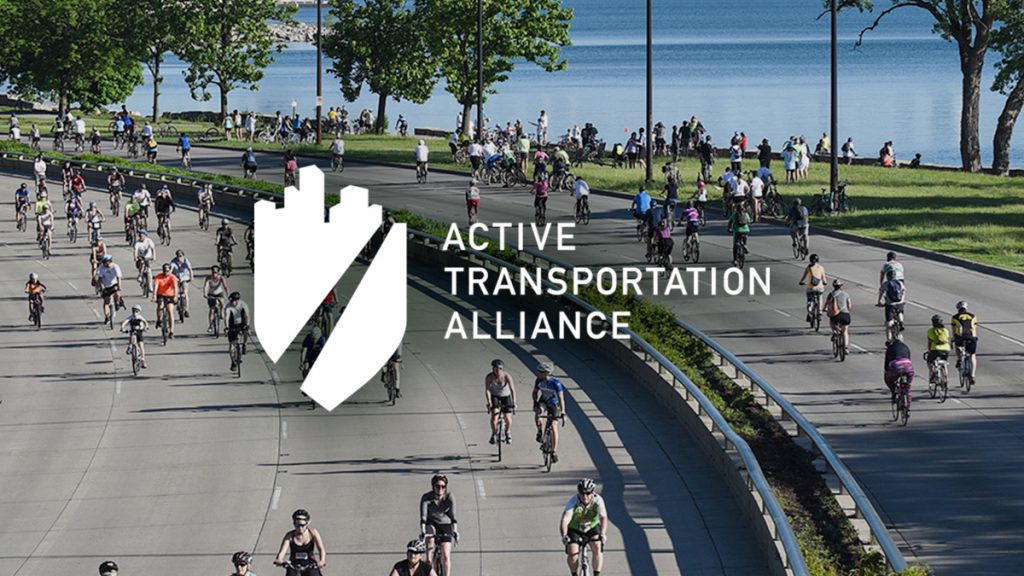On September 18, the Oak Park Village Board will consider a proposal to redesign Madison Street from four lanes to a three-lane road (two travel lanes and a left hand turn lane) with wider sidewalks and parkways, safer crosswalks, bike lanes and streetscape improvements.
Madison would become less like Harlem and North Avenues and more like two lane roads through Oak Park such as Chicago and Ridgeland Avenues.
The project would create a safer, greener, more attractive and walkable street, and it would be funded in part with more than $7 million in TIF funds that are dedicated to improvements on and along Madison.
Click here to send an email to village trustees in support of the Madison makeover. For more information, see below for answers to Frequently Asked Questions.
Question: Isn’t the proposed Madison Street redesign just a bike lane project?
Answer: No. The key changes are narrowing Madison to three lanes (two lanes plus a left turn lane) and improving the parkways and crosswalks. The bike lane is icing on the cake, not the reason for the project. It accounts for roughly 5 to 10 percent of the project’s total costs, and the village has a federal grant to cover about two thirds of that.
Will narrowing Madison to 3 lanes cause significant traffic backups?
Traffic engineers say narrowing Madison would not significantly add time to the drive between Austin and Harlem. And the Federal Highway Administration found that narrowing 4 lane streets with relatively low traffic volumes, like Madison, has little effect on travel times.
This is not surprising when you consider that the number of cars on Madison (18,300 per day) is essentially the same as Ridgeland (18,000 per day), which is two lanes and works just fine. Moreover, the new Madison St. would have a left hand turn lane at each intersection, whereas Ridgeland does not. Madison would not be narrowed between Home and Harlem and Lombard and Austin in order to accommodate cars turning onto Harlem and Austin, many of which are going to I-290.
Is there a safety problem on Madison?
Crashes happen 2 out of every 3 days on Madison St. in Oak Park, with rear end collisions being the most common. Compare this to the three-lane Roosevelt Road between Austin and Harlem, which has 25% more traffic but 30% fewer crashes than Madison St. About 10% of the crashes on Madison involve injuries, and on average 7 pedestrians and cyclists are hit each year. The fear of being hit while crossing Madison as a pedestrian or cyclist is a deterrent to walking and cycling in Oak Park.
How would the redesign improve safety?
Speeding and weaving are commonplace on Madison today. A three-lane configuration would be safer because it limits lane changes and traffic flows more evenly and at speeds appropriate for the neighborhood. A narrower street, along with crosswalk improvements, would make it safer for people on foot and bike to cross, including students who cross Madison to reach the four schools within one block of Madison.
Will narrowing Madison undermine business growth?
Four lane roads work best with big box stores, strip malls and parking lots out front. But the lots on Madison are too shallow and the car traffic too light to attract this type of development. On the other hand, the street is too wide and cars move too fast to attract residential and commercial development that is typical of two lane streets in Oak Park. The Madison Street Business Association knows this, which is why they endorse the Madison redesign. They want a street that is part of the community, not a bypass across it.
Will narrowing Madison hurt existing businesses?
With numerous empty lots and empty buildings, business is not exactly thriving on Madison today. Madison has a hodgepodge of businesses, mainly fast food and small retail. Narrowing Madison is no threat to these types of businesses since they thrive on two and three lane roads just as well as four lanes roads. In addition, with a three-lane configuration, cars would average about the same speeds as today but top speeds would be slower. That’s because drivers won’t “dash, brake and wait” at red lights as much. This helps storefront retail get noticed, and it’s also safer.
Is the project intended to create another pedestrian-focused downtown like Lake St.?
No. The goal is to make Madison a safer, greener, more attractive and walkable street, but not another downtown. Oak Park and neighboring communities have plenty of two/three lane streets that aren’t “downtowns,” and Madison would be no different. At the same time, a narrower street would be more attractive for residential and commercial development that is typical of two/three lane streets in Oak Park.
How much would the project cost?
Consultants have proposed options ranging from roughly $9 million to $17 million. More than $7 million of TIF funds are available that are restricted to projects to improve the Madison corridor.
How would parking be affected?
Parking is underutilized along most of Madison, and the proposal would eliminate 71 parking spots while retaining 636 spots on Madison and adjacent side streets. The narrowing of Madison would account for 29 of the 71 spots reduced.
Will traffic be diverted to other roads?
This is not expected to be a significant problem because a 3 lane road can handle the traffic volumes on Madison (18,000 cars per day) just as Ridgeland, which is mostly 2 lanes, handles 18,000 cars per day. Still, steps can and should be taken to minimize neighborhood cut through traffic and to enhance Washington St.
Organizing Meeting: September 12 at 7:30 p.m.; 616 Wenonah, Oak Park. Join Active Transportation Alliance, Greenline Wheels and the Madison Street Business Association to learn more about the project and how you can help. Please RSVP to [email protected].

